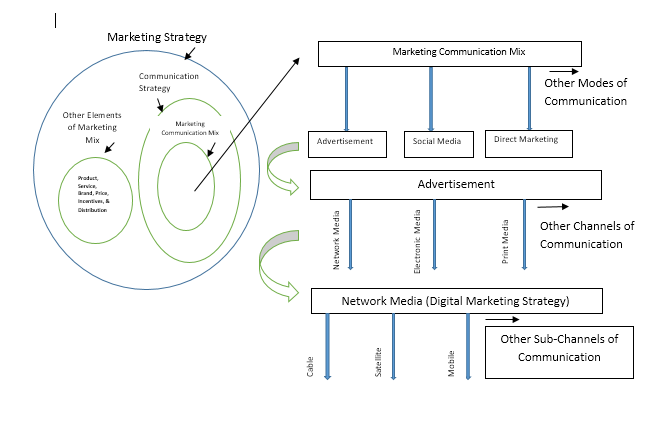Digital Strategy, Digital Marketing Strategy, and Tactics
Integrate the digital technology tools into your business strategy and operations in a way to make it difficult for competitors to copy the advantages you create.
Digital Strategy
In part one “The Nature of Business Strategy,” from the book “The Boston Consulting Group ON Strategy,” the authors describe strategy as “It is probably the business world’s most used and abused word. We have strategies for everything: from advertising to logistics to human resources to custodian engineering. This is a shame, for the concept of strategy is profound and useful.”
If you contemplate the meaning of digital strategy, in light of the above statement, it might create a lot of confusion in your mind. So far, digital strategy has been wrongly interpreted, and no company has been able to properly define it. In this context, is a digital strategy a business strategy or a set of digital tools used to improve performance? And, if “digital strategy” is some kind of strategy, then where exactly does it fit or can be housed in an organization’s hierarchy of strategy?
It seems that there is no correlation between these two terms, digital, and strategy. Digital refers to digital technologies and the application of digital systems (tools) by businesses to solve problems and enhance performance. It might create added value if the advantages do not compete away. Business strategy, on the other hand, is the most important part of any business. It involves a particular set of sequenced activities a firm undertakes to create and deliver value to customers.
Digital technologies not only include SMAC (social, mobile, analytics and cloud) technologies, but also all other tools that work on the principles of digital electronics. Digital technologies have created tools for businesses that support and complement activities in the firm’s value chain to achieve operational effectiveness-low cost, speed, flexibility, performance, and productivity—by performing these activities better than competitors. This improvement in operational effectiveness can generate added value for the firm. But the fear here is that your competitors can easily imitate your operational advantages, and therefore can nullify the added value you generate. The key here is to integrate the digital technology tools into your business strategy and operations in a way to make it difficult for competitors to copy the advantages you create. For example, Zara, a retail chain of clothing stores, uses several factors, including low prices, speed of delivery, and flexibility, to gain a competitive advantage over its rivals. Therefore, digital strategy is not a business strategy, but the use of digital tools in your firm’s activities to create advantages. Another way to create an advantage is to integrate digital technology- to enhance your resources and capabilities to develop unique products and processes, to create overall superior value.
Digital Strategy as Part of Operations Strategy or a Separate Functional Strategy
From the above discussion, we see that digital technology is part of an operations strategy. Because operations strategy also deals with the optimum level of technology, the firm uses in its operations to generate added value. Digital and other technologies have been supporting operations for a long time now. For example, Advanced Manufacturing Technology (ATM) integrates computer-aided design and manufacturing (CAD/CAM) principles, and computer numerically controlled (CNC) systems into the operations to improve products and processes.
Likewise, a digital strategy can also be considered as a separate functional strategy—to provide digital technology support to all other functions in the organization, including the business strategy. For example, just as the function of human resource management strategy, a functional strategy is to provide human resources, and administrative support to all other functions in the organization, the function of digital strategy should be to provide digital technology support to all other functions in the organization including the business strategy.

Figure 1.0 Hierarchy of Marketing Strategy
Digital Marketing Strategy
From the structural perspective, a business model comprises two important components: strategy and tactics. And from a marketing perspective, marketing strategy also comprises two main components: target market and value proposition. A firm’s communication strategy is a subset of its marketing strategy (See Figure 1.0). And, further, the marketing communications mix is a subset of the communication strategy. The marketing communications mix typically comprises eight major modes of communication defined as sub-operations strategies the firm can use to reach people and convey its message. Each mode of communication can further be divided and subdivided into specific channels and sub-channels. At this point, the digital marketing strategy’s function can be housed into any or all modes, channels, or sub-channels the firm desires to use. For example, advertisement, direct marketing, social media, and product-based communication are modes of communication, and print media, electronic media, network media are channels of communication of the advertising mode, and telephone, cable, satellite, wireless are sub-channels of network media. Here, the electronic media and network media are digital channels, and the sub-channels of network media are also digital. It is important to note here that functional level strategies are strategic and tactical in nature at the functional level and tend to become more operational in nature as they further descend to sub-functional levels and below.
Based on the above discussion, we conclude that digital marketing strategy should also comprise two key components-target audience and value proposition. Therefore, the purpose of digital marketing strategy is to identify the target audience the company desires to target through its digital communication campaign and convey to them the benefits of the offering.
Because marketing strategy is a functional strategy, and as it supports the firm’s overall business strategy goals and objectives, and aligns with the firm’s overall business strategy, the digital marketing strategy as a sub-functional part of the communication strategy, must also support the firm’s marketing and business strategy. Additionally, because of this relationship to functional strategy, the digital marketing strategy should be concerned with developing distinctive competencies and improving resource productivity in the area of digital marketing to develop and sustain competitive advantage.
Digital Marketing Tactics
Just like the communication strategy as described above, the digital marketing strategy components (strategy & value proposition) drive the development of the digital communication campaign. This process comprises three steps: (1) Designing the digital communication tactics, (2) Developing an implementation plan, and (3) Evaluation and control. Here, in step 1, the digital communication tactics are also called digital marketing tactics. The digital marketing tactics can further be disaggregated into three steps: (1) message, (2) media and, (3) creative solutions. Thus, the purpose of digital marketing tactics is to design, communicate, and deliver the appropriate message through the right digital channels to the right audience by using digital technologies. Here, the two terms “appropriate message” are related to one or more components of the “seven tactics” or “7Ts” of the marketing mix variables: product, service, brand, price, incentives, communication, and distribution. This 7-T framework of tactics is an upgraded and refined version of the old 4-P framework of tactics which describes the marketing mix variables in terms of four factors: (1) product, (2) price, (3) place, and (4) promotion.
References and Further Reading
- Carl W. Stern and Michael S. Deimler, The Boston Consulting Group ON Strategy (New Jersey: John Wiley & Sons, Inc., 2006), p. 1.
- Gerald et al., “Strategy, not Technology, Drives Digital Transformation,” MIT Sloan Management Review (July 14, 2015), Chapter 6.
- M. E. Porter, Competitive Advantage (New York: Free Press, 1998), p. xviii.
- M. E. Porter, “Strategy and the Internet,” Harvard Business Review (March 2001), pp. 1-19.
- Mark M. Davis, Nicholas J. Aquilano, and Richard B. Chase, Fundamentals of Operations Management (New York: McGraw-Hill/Irwin, 2003), Chapter 2.
- T. L. Wheelen & J.D. Hunger, Strategic Management & Business Policy (New Jersey: Prentice-Hall, 2000), pp.160-167.
- Philip Kotler and Kevin Lane Keller, Marketing Management (New Jersey: Prentice-Hall, 2012), P. 478.
- A. Chernev, Strategic marketing Management (USA: Cerebellum Press, 2014), Chapters 2, 12, and 20.
- Ken Favaro, “Don’t Draft a Digital Strategy Just Because Everyone Else Is,” Harvard Business Review (March 16, 2016).

Comments
Want to join the discussion?Feel free to contribute!